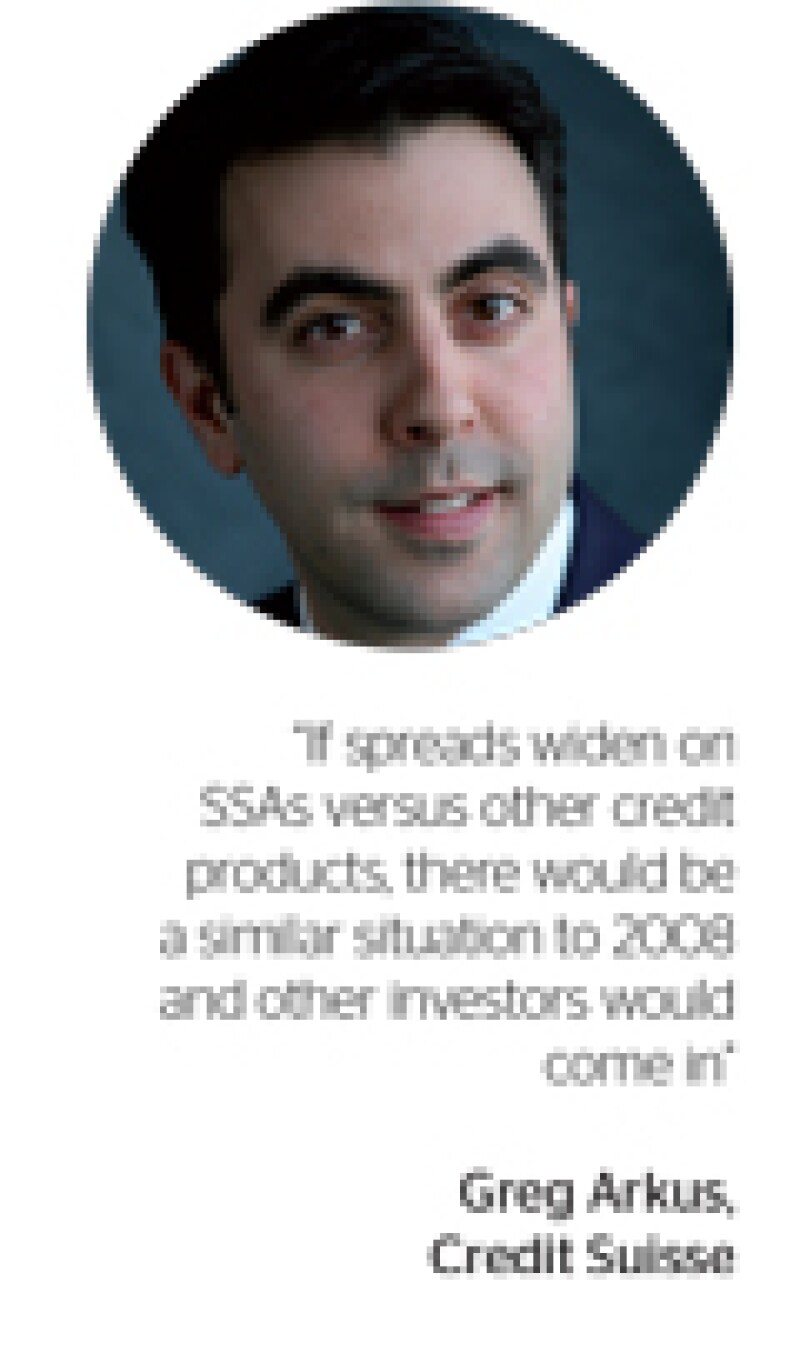Sovereigns, supranationals and agencies are likely to seek cash as early as possible in 2016 — meaning the problem of crowded markets could be particularly acute in January as they seek to tap the rich seam of cash available that month.
“More issuers than usual will be trying to access the natural peak in cash that investors tend to have at the start of the year,” says Lee Cumbes, head of SSAR DCM at Barclays in London.
“The trend in the most recent years, where issuers have tried to spread borrowing more evenly, is likely to revert to front loading, as they will be aware that there may not be large amounts of free cash available every week. That’s particularly true in dollars, where the investor base has changed.”
Issuers cannibalising one another’s deals is typically a sign of distressed markets. But with Greece beginning its third bail-out package, talk of a eurozone break-up firmly in the past and major central banks worldwide still in accommodative mode — even if some have their eye on tightening policy, interest rates are still at or near record lows — it would seem to be anything but a distressed market.
But in October, a pair of Dutch issuers — Bank Nederlandse Gemeenten and Nederlandse Waterschapsbank — both brought similar deals on the same day.
NWB Bank had circulated initial price thoughts on October 13 for a €250m tap of its April 2030s, but a day later when it planned to price the deal BNG brought a near identical bond — with very different price thoughts. BNG’s €500m October 2030 had price thoughts 6bp wider than those circulated by NWB Bank.
It was the first time NWB Bank and BNG had been out with an identical maturity and currency on the same day.
The situation reminded some bankers of when KfW and the Inter-American Development Bank both brought five year dollar deals on the same day in June.
Before 2015, the last time some SSA bankers can remember issuers coming out on top of one another was in 2009 — not long after the Lehman Brothers bankruptcy.
“We have seen issuers coming out with the same deals on the same day before, but only in a distressed market,” says Jamie Stirling, global head of SSA DCM at BNP Paribas in London.
“From the outside looking in, these markets look functional. But there is a huge underlying concern with regard to secondary liquidity that’s driving real execution risk.”
SSA bankers are concerned that the problem could be even worse in 2016, not least because of regulation and costs making it difficult for banks to offer liquidity.
“We expect to see more of this kind of thing in January,” says Stirling. “There’s likely going to be a race to issue because of a first mover advantage. Look at the underlying dynamics — you’ve maybe got rising yields in dollars, swap spreads remaining negative throughout the curve and less liquid secondary markets which all lead to greater volatility and shorter issuance windows.
“It feels like credit spreads are only going to get wider. Issuers are talking about specific days they want to access funding and the market is only able to take a certain amount of volume, so credit spreads will only widen.”
Issuance windows narrow
But while spreads widen, investors are still likely to demand the same sort of new issue premia they have been used to — which could create a vicious circle.
“We’re going to see more of what happened in the last few months of 2015 — higher new issue premiums forcing secondary spreads wider, investors demanding consistent premiums despite the widening — which puts further pressure on the market,” says Greg Arkus, head of SSA DCM at Credit Suisse in London.

“Spreads in dollars may go wider, although European Central Bank quantitative easing should constrain spreads in euros. But the basis swap will make dollars look more attractive for issuers funding in euros, which makes the dollar market busier.
However, if demand is robust and the basis swap allows, then this could be alleviated as euros become more attractive for dollar-based issuers.”
One of the major factors that is likely to lead to deal jams is that issuers are having to fund in ever narrower windows. That is only likely to be a bigger problem in 2016 — even though overall volumes are not expected to be much changed.
“Given ECB QE, we’re going to potentially be looking at even more negative rates in euros,” says Arkus. “That’s going to be coupled with the US Federal Reserve hiking rates. Dollars will represent an attractive proposition, as relative pricing will be better thanks to the euro/dollar basis swap.
“But a Fed hike might increase volatility, which tightens windows for issuance. We’ll have very short windows and lots of competition for them. We expect underlying demand for SSA product to be robust but this could make the environment more challenging during the first half of 2016.”
Reasons for optimism
The outlook for 2016 is not all bad, however. The very spread widening that could make deals more expensive may at least offer the bonus of issuers being able to diversify the investors in their books.
“If spreads widen on SSAs versus other credit products, there would be a similar situation to 2008 and other investors would come in,” says Arkus. “When the Fed hikes there’ll be less issuance from corporate borrowers that have been keen to lock in low yields, which could mean a dearth of supply of corporate credit. With SSAs offering a decent spread versus other comparable issuers, it could bring in some asset managers in the first quarter.”
Issuers could also increase the geographical diversity in their books.
“If dollar yields move higher then this may unlock new investor activity,” says Barclays’ Cumbes. “For instance, outright investors in Japan might want to buy, depending on currency moves.
“Historically, the Bank of England rates tend to follow the Fed in terms of direction of rates, so if we see higher yields and stronger sterling in currency markets, that may attract international demand too. We should see some room for optimism there.”
Generally, investors are likely to be keen to snap up paper, say other SSA bankers.
“Investors have a lot of cash to put to work,” says Sean Taor, head of European DCM at RBC Capital Markets in London. “Some had a relatively poor performance in 2015 and it’s likely that demand will be strong in 2016. “Investors will be buying SSA product again, although timing wise it could be volatile.
“It is likely that the markets will be less predictable in 2016. But I’m bullish on the SSA market in that I’m not as worried about issuers’ ability to raise funds, but I can see that spreads will drift wider as rates go up in the US.
There may be windows where it’s trickier to issue and there could be more uncertainty, but I don’t think it’s going to be as difficult as some market participants expect.”
Political pauses
One of the biggest roadblocks to issuance in 2015 was the talks between the Greek government and its international creditors over a third bail-out, which dragged on through the summer before finally reaching a resolution in August.
There were other political jolts late that year — not least a short lived Portuguese government, that won power after a narrow election but was shortly brought down by a coalition of opposition parties. That grouping — made up of left-wing parties that took a harsh tone on the austerity measures of its predecessor — took power in November.
A move against austerity could change the outlook for issuers in 2016.
“Greece uncertainty has gone away for now but the Portuguese elections have highlighted the bigger issue in Europe,” says Taor. “Austerity has had major implications politically, the level of debt outstanding is still very high and growth in Europe is still effectively flat.
“That’s the longer term problem.”
But while such political events may take issuance off the table temporarily, there seems to be have been little impact on the affected sovereigns’ borrowing costs.
“The market reaction to the Portuguese government falling was that yields went up and spreads widened, but then they came back very quickly,” says Credit Suisse’s Arkus.
“There’s no alternative in terms of what else to buy. That will keep the periphery pretty well supported. Further QE will boost that as well, as it pushes investors into higher spread products.”
But while the influence of the ECB means SSAs may not have to worry about rising borrowing costs, they may have to focus on larger funding needs as they cope with the influx of people fleeing warzones in the Middle East.
“A shorter term problem will be the effect of migration into Europe and the added burden on local finances and regional finances, which I think is underestimated,” says RBC Capital Markets’ Taor.
“Governments are cutting down on local spending, local governments are under pressure anyway, so the added cost of migration will be a real challenge. That will mean extra debt raising needs for regional issuers. The whole migration problem is desperately sad but it will be one of the biggest challenges Europe faces next year.”







